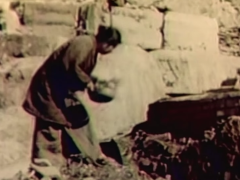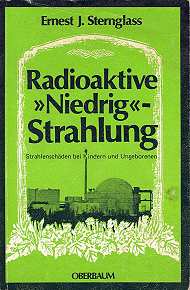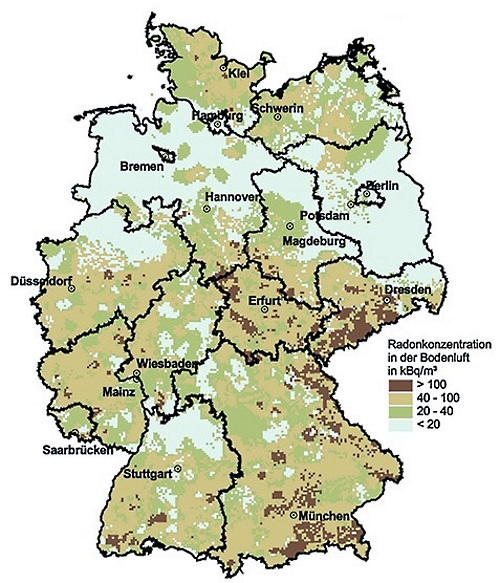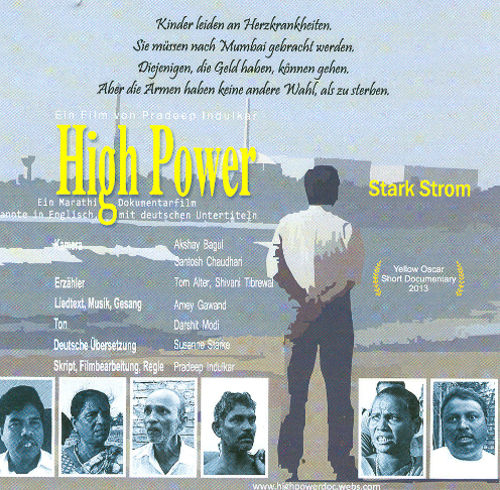| Map of the nuclear world | The uranium story |
| INES and the nuclear accidents | Radioactive low radiation?! |
| Uranium transports through Europe | The ABC deployment concept |
Low level radioactive radiation?
Ionizing radiation!
***
Low-level radioactive radiation is ionizing radiation that affects us in low doses and accumulates over time!
On the background of radioactivity and the findings on the subject 'low-level radioactive radiation' I'll come to the bottom of this page in more detail. Before doing so, however, I would like to address the effects of massive exposure to ionizing radiation has on people. Because 'low radiation', as harmless as the word may sound, becomes 'enjoyed' more and more dangerous in the long run.
accumulated radioactivity; This means that radioactive particles continue to accumulate in the living organism and over time damage similar to that which occurs with short-term, massive exposure to radiation becomes visible...
| Massive radiation | low-level radioactive radiation |
| Radioactivity | The INWORKS study |
Massive Radiation - The Consequences
The world's first atomic bomb test 'Trinity'On July 16, 1945 in New Mexico, a plutonium bomb exploded and provided the first hard data. By 1993, the United States had carried out 119 above-ground nuclear weapons tests in the Nevada desert (only about 100 km north of Las Vegas) and the 67 above ground Nuclear weapons tests on the South Seas Atoll Bikini, further data collected.
 In the beginning, radioactive radiation wasn't really on the screen, actually it was only about the big bang, the immensely destructive power of the bombs.
In the beginning, radioactive radiation wasn't really on the screen, actually it was only about the big bang, the immensely destructive power of the bombs.
In Las Vegas, Nevada, Atomic parties were held on the roof terraces of hotels in the 50s.
There were 'Atomic drinks' and lots of other 'Atomic attractions' and in the early morning, at the height of the party, there was the 'Atomic lightning bolt' and the brightly colored atomic mushroom cloud over the northern sky.
At one of these parties in 1957 the first "Miss Atomic Blast" was chosen.
Up until the 60s the rain was radioactive and the number of cancer cases exploded, not just in Nevada.
But since it was always and primarily about the security of the country, were Liability, damages, etc. Absolutely taboo subjects, people didn't talk or write about them. That only changed after the nuclear tests in the Pacific.
Since 1945 there have been over worldwide 2050 nuclear weapons tests ...
*
Atomwaffen A-Z
Radiation effect on people
Ionizing radiation is a hostile cause of disease that has threatened life on earth from the very beginning. Life evolved in constant defense against radiation damage. Any increase in harmful noxae disturbs the biological equilibrium. Through the use of atomic energy, the radioactive inventory of this earth and thus its disease-causing potential are constantly increased.
*
IPPNW information
Expert meeting in Ulm - dangers of ionizing radiation
Doctors and scientists warn of damage to health from ionizing radiation. Even radiation doses in the range of 1 millisievert (mSv) have been shown to increase the risk of illness. There is no threshold below which radiation would be ineffective.
*
Stochastic radiation damage: When the radiation effect only occurs years later.
The atomic bombs on Hiroshima and Nagasaki and the Chernobyl reactor disaster caused stochastic radiation damage to the population. How the type of damage occurs and which diseases can be caused ...
*
YouTube
Search results at YouTube on the subject: atomic bomb tests
https://www.youtube.com/results?search_query=Atombombentest+doku
e.g. Cylinders, Dishes,
 https://www.youtube.com/watch?v=8fneqsVChLE
https://www.youtube.com/watch?v=8fneqsVChLE
- The most powerful bomb in the world -
The hydrogen bomb:
The 'Castle Bravo' test on Bikini Atoll and the 'Tsar Bomb' on Nova Zemlya!
(Arte, 2012, 52:16)
*
The 'better', because statistically more relevant data on massive radioactive contamination (realistic scenario, no laboratory conditions) have been about since August 1945 on the basis of the suffering of the survivors of the atomic bombs Hiroshima and Nagasaki (August 06, 1945 Hiroshima and August 09, 1945 Nagasaki) from a scientific point of view, conscientiously collected and bureaucratically correct and properly documented.
Within the first 800 meters from the epicenter of the Hiroshima explosion, 90% of the people (70.000 to 80.000) died instantly, the other 10% did not survive 1945. The individual development of the Radiation sickness was observed and recorded on over 80.000 people in Hiroshima. These Hiroshima survivors were people who were killed at the time of the explosion of 'Little Boy'' were at least 0,8 to 1 km, 2 km or 3 km from the location where the uranium bomb was dropped.
*
Search results at YouTube on the subject: Atomic bombs
https://www.youtube.com/results?search_query=Atombomben+doku
e.g. Cylinders, Dishes,
 https://www.youtube.com/watch?v=F6O7VvDl-Bo
https://www.youtube.com/watch?v=F6O7VvDl-Bo
-Hiroshima-
Shadow of a tragedy
The consequences of the uranium bomb over Hiroshima.
(National Geographics, 2010, 1:56:07)
*
The explosion of the plutonium bomb 'Fat man'About Nagasaki killed another 30.000 people immediately and another 45.000 people died by the end of 1945. In Nagasaki, many thousands of people also died of radiation sickness in the following years (estimates: 1946 ≈ 75.000, 1950 ≈ 140.000).
The human body cells die. With such massive radiation, the cells of the skin die first and then the deeper blood vessels. The immune system collapses and multiple organ failure is the result.
 https://www.youtube.com/watch?v=6UtaGtjtwWg
https://www.youtube.com/watch?v=6UtaGtjtwWg
-Nagasaki-
Why did the second bomb fall?
The causes and consequences of the plutonium bomb over Nagasaki.
(ARD, 2015, 44:00)
*
So since the 1940s, massive amounts of artificial radiation have been released: INES and the disturbances in nuclear facilities.
The following map was created from this data, among other things:
The map of the nuclear world

 Causes of man-made radioactivity, from uranium mining, uranium processing and research, the construction and operation of nuclear facilities, including incidents at nuclear power plants and nuclear factories, to the handling of nuclear weapons, uranium munitions and nuclear waste.
Causes of man-made radioactivity, from uranium mining, uranium processing and research, the construction and operation of nuclear facilities, including incidents at nuclear power plants and nuclear factories, to the handling of nuclear weapons, uranium munitions and nuclear waste.
Everything to do with atomic research was and is classified as 'secret' by the military. The reports, statistics and data on the health of the soldiers who attended the Atomic bomb explosions were of course also subject to confidentiality, as were the data on the survivors of Hiroshima and Nagasaki, as well as the research reports on the development of the health of the population on the neighboring islands of Bikini Atoll.
Whistleblower, who were often called “traitors” then and now, brought these findings to the public. The choice of words says a lot about the state of a society (But that's another topic...)
| Massive radiation | low-level radioactive radiation |
| Radioactivity | The INWORKS study |
low-level radioactive radiation
The consequences of “ionizing radiation”
Andrei Sakharov (* May 21, 1921 in Moscow; † December 14, 1989 there), the intellectual originator of the Soviet hydrogen bomb (Tsar bomb, AN602), was convinced that every megaton of explosive force of every nuclear bomb attempt claims over 10.000 victims. Not immediately and not through the force of the bomb explosion or the heat of the fire, but over generations, 10.000 victims per megaton of explosive force will be mourned because the people of the fallout - ionizing radiation - were exposed. According to Sakharov's calculations - 1950 megatons had already been tested by the end of the 50s - that is, 500.000 dead. The atomic bomb tests continued until the early 1990s.
1958 Andrei Sakharov published the article in the magazine 'Atomenergie':
The radioactive carbon of nuclear explosions and the threshold-independent biological effects. (PDF file)
These warnings were ignored by the Soviet leadership, Andrei Sakharov fell out of favor and the Tsar bomb (video) was detonated on October 30, 1961.
*
Professor Ernest J Sternglass (* September 24, 1923 in Berlin; † February 12, 2015 in Ithaca, New York) wrote 1977 a book on the subject:
"Low" radioactive radiation:
Radiation damage in children and unborn babies = low level radiation
 Professor Ernest J. Sternglass worked in the Westinghouse Research Laboratories since 1952 and was there from 1960 to 1967 head of the Apollo program.
Professor Ernest J. Sternglass worked in the Westinghouse Research Laboratories since 1952 and was there from 1960 to 1967 head of the Apollo program.
He had been working with low-level radiation since 1963 and warned early on about the dangers posed by “low-level radioactive radiation”.
An important finding of his research work was:
If ionizing radiation is absorbed in low doses over a longer period of time, the consequences of this radiation exposure can correspond to those of short-term but massive radiation, but possibly only years or even generations later (DNA damage) become visible.
The actual cause of the damage can then hardly be determined. Or does it?
Read the scinexx article from June 10, 2022 Mutations torpedo doctrine and the July 29, 2016 Apollo astronauts: were there any long-term effects? Striking accumulation of cardiovascular diseases among space veterans - 40 years after the publication of the book, the theses of Prof. Sternglass are confirmed.
Interview with Prof. Sternglass (PDF file) from 2006.
Issues such as low level radiation and how it accumulates in living tissue are difficult to understand and impossible to comprehend. Radiation cannot be seen, it cannot be smelled, it cannot be tasted, and such complex abstract knowledge can be pushed out of consciousness.
Pavlov's dog would have a lot to tell us about this if he could.
Information overload, conditioning, consumer control and the attention economy...
*
More than 2050 nuclear weapons tests ...
The organization IPPNW International Doctors for the Prevention of Nuclear War estimates that 2-3 millions of people at the consequences of the "ionizing radiation", based on above-ground nuclear weapons tests, died. In total, over 1945 above-ground nuclear weapons tests and over 520 underground tests have been carried out worldwide since 1500. The explosive power of the above-ground tests alone corresponded to that of 29.000 Hiroshima bombs. (Source: ican)
*
Atomwaffen A-Z
Radiation effect on people
Ionizing radiation is a life-threatening disease that has threatened life on earth from the start. Life has evolved in constant defense against radiation damage. Any increase in life-hostile noxae disturbs the biological balance. Through the use of atomic energy, the radioactive inventory of this earth and thus its disease-causing potential are constantly increasing. As a direct result of radioactivity, the affected cells suffer severe functional disorders. They can no longer divide or even die...
*
BfS - Federal Office for Radiation Protection
What is ionizing radiation?
Radiation transports energy - starting from a radiation source.
The energy is transported in the form of electromagnetic waves (such as with visible light or X-rays) or as a particle stream (for example with alpha / beta radiation).
With ionizing radiation there is a greater energy transport (per photon) than with visible light or with infrared radiation (thermal radiation). This can change matter into which ionizing radiation penetrates. Specifically, atoms or molecules are ionized, that is, electrons are "knocked out" of the shell of atoms or molecules. The remaining atom or molecule is then (at least for a short time) electrically positively charged. Electrically charged particles are called ions.
When ionizing radiation hits living cells or organisms, it can cause more or less severe damage in the cells and organisms through these ionization processes or through other changes in molecules.
*
Ionizing radiation
Ionizing radiation can be generated technically (X-rays) or arise when certain atomic nuclei decay radioactively (alpha, beta, gamma and neutron radiation). When certain atomic nuclei transform themselves into other nuclei without external influence and emit high-energy radiation (ionizing radiation), this property is called radioactivity. The process of nuclear transformation is known as radioactive decay. The radioactive atomic nuclei are called radionuclides.
Even when atomic nuclei are fissioned, for example in the fuel rods of a nuclear reactor, ionizing radiation is generated in addition to the fission products.
Depending on the starting material, stable or radioactive decay products arise during radioactive decay, which in turn can further decay. Radioactive substances emit ionizing radiation until the "last" radionuclide has decayed.
*
Hereditary radiation damage
Works ionizing radiation on gonads (testicles or Ovaries) or germ cells (spermatozoa or Egg cells), it can cause damage to their genome (mutations), which can lead to genetic diseases (genetic damage). These can affect the children and grandchildren of the irradiated persons in the form of malformations, metabolic disorders, immune damage etc. have an impact, but also only become visible after many generations. As with cancer, a genetic disease cannot determine whether it is due to its clinical appearance Radiation exposure is due...
*
The Petkau Effect
states that lower doses of radiation are more likely to cause genetic damage over a longer period of time.
hormesis
is the hypothesis that small doses of harmful or toxic substances can have a positive effect on organisms.
*
Search all contents of the 'reactor bankruptcy' with the search term:
| Massive radiation | low-level radioactive radiation |
| Radioactivity | The INWORKS study |
What is 'radioactivity'?
Radioactivity cannot be seen, smelled or tasted
Radioactivity can only be measured with expensive devices (Geiger counter) and their measured values can be evaluated, weighted and interpreted differently by experts.
For many years it was no problem for the representatives of the nuclear industry to sweep critical questions off the table as unfounded scaremongering. 'In the studies available to us there is no evidence of this ...' was the standard saying. For this reason, references to the dangerousness of 'radioactive low-level radiation' were and are usually only acknowledged with a shrug of the shoulders by large parts of the public.
Both in the general public and in politics one naturally trusted the omniscient doctors from the powerful industry that promised 'wealth and prosperity for everyone', and hardly anyone really knew exactly what the subject of 'radioactive low radiation' was actually about ...
It was then and is still about radioactivity, ionizing radiation that affects us every day ...
*
Radioactivity is in Sievert (Sv) measured
Since a dose of Lv 1 is already a very large value, the values that usually occur are expressed in millisieverts (mSv), Microsievert (µSv) or Nanosievert (nSv).
| millisievert | 1 mSv = 0,001 Sv |
| Microsievert | 1 μSv = 0,000 001 Sv |
| nanosievert | 1 nSv = 0,000 000 001 Sv |
In Germany, the limit value for the effective annual dose to protect individual members of the population is 1 mSv. The maximum permitted effective annual dose for occupationally exposed persons is in Germany 20 mSvsystem. (3.)
From a short-term irradiation with Lv 0,5 (500 mSv) the first symptoms of radiation sickness appear. (4.)
A dose of Lv 1 received a person who was about 2 km away from the Hiroshima atomic bomb. That meant acute radiation sickness, long-term damage and up to 10% mortality after 30 days.
*
Becquerel (unit)
Becquerel [bɛkə'rɛl], unit symbol Bq, is the SI unit of activity A of a certain amount of a radioactive substance. The average number of atomic nuclei that decay radioactively per second is given:
1 Bq = 1 s−1 (i.e. one Becquerel corresponds to one radioactive decay per second)
Since 1 Bq is an extremely low activity, very large numerical values occur in practice. Therefore, prefixes are often used for the magnitude (mega-, giga-, tera-, ...)
1 TBq = 1 (000 to the power of 000) Becquerel
Approximately 5,2 million TBq terabecquerels were released in Chernobyl.
***
 Radon map from BfS Federal Office for Radiation Protection
Radon map from BfS Federal Office for Radiation Protection
Low radioactive radiation adds up
and is composed as follows:
1. Natural radiation exposure:
By cosmic and terrestrial radiation.
1a. Radiation from outside, e.g. from the sun.
1b. Radiation from within, based on uranium deposits in the earth, e.g. from escaping radon gas.
These two sources of natural radiation have existed, with fairly constant values, for millions of years ...
The entire natural radiation exposure in Germany is average 2,1 mSv in the year. Depending on where you live (Uranium mining, e.g. in the Ore Mountains), diet and lifestyle habits are values between 1 mSv and 10 mSv measured.
more
2. Artificial radiation exposure:
By radiation that penetrates us during radiological examinations and / or on air travel.
We have known X-rays since 1895 and mass tourism with airplanes since the 1960s, both of which are fairly new inventions, but which are enjoying steadily increasing popularity ...
2a. The mean X-ray radiation per inhabitant in Germany for 2012 was around 1,8 mSv per year (effective dose), almost as much as the average natural dose.
2b. A flight from Frankfurt to New York and back leads to an average effective dose of approx 0,1 mSv. Such a transatlantic trip increases the mean annual radiation exposure by around five percent.
more
3. Artificially generated radiation exposure:
By radiation released into the environment when uranium, plutonium etc. were used.
3a. A small part of the radiation exposure is due to the normal operation of nuclear facilities, for example. Nuclear power plants.
3b. Significantly higher levels of pollution arise from accidents in nuclear facilities.
*
For the first year after the Chernobyl accident, an additional average effective dose of 1,0 mSv in Bavaria and 0,1 mSv calculated in North Rhine-Westphalia. The current additional radiation exposure in Germany from the reactor accident is still approx. 16 µSv in the year.
Nuclear weapons tests now fall with approx. 5 µSv in the year in Germany is no longer so important. In the 1960s, however, the radiation exposure from nuclear bomb tests for Central Europeans was higher than 1,0 mSv.
*
The nuclear industry lobbyists kept repeating it for 70 years: "Show us proper studies with reliable data, facts and evidence ...".
Of course, these wise guys knew only too well that such "proper studies", extremely lengthy and therefore also very expensive, were almost impossible for the critics of the nuclear industry to obtain. If a research team did manage to raise some money to start a study, there were always other researchers who were willing to discredit such critical studies as "not properly".
An example: The KIKK study from 2007. The conclusion of the Kikk study was:
"The closer you live to a nuclear power plant, the greater the risk of cancer for children."
In 2010 the KuK study, whose conclusion: “There is no connection between malformations and the distance from where you live to a nuclear power plant.” The IPPNW criticizes what to make of this, Protecting aid for the nuclear industry from July 21, 2010, quite clearly to the point.
| Massive radiation | low-level radioactive radiation |
| Radioactivity | The INWORKS study |
The INWORKS study
On June 21, 2015 the INWORKS study in "The Lancet Hematology" (7.). The INWORKS study is based on the measurement data of 300.000 workers in nuclear power plants; this data goes back as much as 60 years. To do this, the following article scinexx:
Leukemia even with the slightest amount of radiation
Study on workers in nuclear power plants shows the carcinogenic effects of low radiation doses
There is no harmless dose: even the slightest exposure to ionizing radiation is sufficient to increase the risk of leukemia and lymphoma in the long term. This is confirmed by the largest study to date on this topic on more than 300.000 workers in nuclear power plants. Contrary to popular belief, there is no lower limit and a sustained low dose is just as carcinogenic as a single higher acute exposure, as the researchers report in the specialist journal "Lancet Hematology".
It has been argued for years how harmful even the smallest doses of ionizing radiation are. In 2007 a study caused a sensation that increased Child leukemia in the vicinity of nuclear power plants found. Last year (2014) researchers found that there was already a slightly increased background radiation doubled the risk of leukemia and brain tumors in children.
A good 300.000 nuclear power plant workers
An international team of researchers led by Klervi Levraud from the French Institute for Radiation Protection and Nuclear Safety has now re-examined the risk of low radiation doses in the largest study of its kind to date. They evaluated the health data of more than 308.000 workers who had worked in nuclear power plants in France, Great Britain and the USA for at least a year.
Because these workers have to wear dosimeters during their stay in the power plant and the values are recorded, it is possible to determine afterwards which radioactive pollution they were exposed to. The researchers determined how many of these workers developed leukemia or lymphoma and how many of them died from it. Your data went back up to 60 years.
Increased leukemia rates
The result: On average, the radiation exposure of the power plant workers was relatively low: per year it was only about 1,1 millisievert above the mean background radiation, which is 2 to 3 millisievert. The cumulative radiation dose to workers averaged 16 millisieverts. For comparison: Even a computed tomography of the trunk leads to a short-term radiation exposure of 10 millisieverts.
Despite their actually low exposure, 531 workers died of leukemia, 814 of lymphoma and 293 of multiple myeloma, according to the researchers. But that was much more than expected. Because in the general population, the leukemia rate is 4,3 per 10.000 people - therefore only 134 workers should have died from the blood cancer.
Linear trend even at the lowest doses
More detailed evaluations showed that within the study participants the risk of leukemia increased linearly with the radioactive exposure. "The trend in the additional relative risk can be well described by a simple linear function of the cumulative dose," said Levraud and his colleagues. This connection can be seen most strongly in chronic myeloid leukemia, but also in acute leukemia and various forms of lymphoma.
According to the researchers, the linear trend can be continued even at very low radiation doses. In mathematical terms, for every 10 millisieverts of cumulative radiation dose, the risk of leukemia increased by 0,002 percent. "Our results thus provide direct estimates of the risk per radiation dose received - in areas that correspond to the typical loads in the environment, medical applications and other activities," emphasize Levraud and his colleagues.
"Clearly positive connection"
"We have thus demonstrated a positive relationship between the cumulative dose of ionizing radiation in adults and death from leukemia, even at low doses," say Levraud and his colleagues. This correlation did not disappear when the researchers looked at the countries individually or considered other influencing factors such as the socio-economic status of the participants. And the study shows something else: Contrary to popular belief, sustained, low levels of radioactivity are just as harmful as short-term, acute radiation.
"This is a solid, unusually extensive study on the consequences of long-term, very low exposure to ionizing radiation," comments Jørgen Olsen from the Danish Cancer Research Center in Copenhagen in the journal Nature. The results underscore that there are no harmless doses of radiation. Even slightly elevated background values can therefore be sufficient to increase the risk of leukemia - albeit only minimally in relation to the individual.
Radiology employees also potentially at risk
This is unlikely to change much for workers in nuclear power plants. The limit values of the International Commission on Radiation Protection (ICRP) for the maximum radiation exposure are for you a maximum of 20 millisieverts per year over a five-year period and an annual maximum of 50 millisieverts.
However, the study draws attention to another, potentially endangered professional group: people who work in radiology. "These medical workers are also exposed to low doses of x-rays or gamma rays," the researchers explain. "So far, there are no precise estimates of their dose-dependent leukemia risk because there are no dosimeter data for this occupational group. However, an earlier study had already found that leukemia is twice as common in people who have worked in radiology for more than 30 years as in the population average.
(Lancet Hematology, 2015; doi: 10.1016/S2352-3026(15)00094-0)
IRSN - Institute for Radiological Protection and Nuclear Safety
*
As was to be expected, the counterattack by the Strahlemanns came immediately: Dr. Mohan Doss, associate professor at the Fox Chase Cancer Center in Philadelphia, contradicts the INWORKS study and accuses it of a serious error: the authors only took into account the employees' occupational radiation exposures, but left out their medical radiation doses.
I understand it in the same way as Erich Mielke did when he made his famous appeal to the subjects, when the GDR was already in the phase of dissolution: Dear employees of our safe nuclear power plants, please don't go on vacation that often and don't go to the Doctor and if you do, at least don't get an X-ray there, we love you all ...
| Massive radiation | low-level radioactive radiation |
| Radioactivity | The INWORKS study |
Notes and additional links:
Something fundamental has changed in the situation in recent years; the mood of the subjects. The public has learned and has become more suspicious of the statements of the authorities and the rhetorical tricks of the nuclear industry lobbyists (9.). In addition, the scientific processing of the nuclear disasters of Chernobyl (1986) and Fukushima (2011) has contributed to the fact that there is now more information on low-level radioactive radiation. The nuclear proponents are slowly but surely losing ground ...
*
*
Low radiation, ionizing radiation
*
2a. Background radiation is one that fills the entire universe isotropic radiation in the microwave range, which arose shortly after the Big Bang (not our topic).
*
3. Radiation Protection Ordinance
*
4. Symptoms of radiation sickness
*
5. The KIKK study from 2007
*
6. The IPPNW on the Kuk study, Protecting aid for the nuclear industry
*
7. INWORKS study: an international cohort study - "The Lancet Hematology" -
Ionizing radiation and risk of death from leukemia and lymphoma in radiation-monitored workers
For work on 'THTR circular', 'reaktorpleite.de' and 'Map of the nuclear world' we need up-to-date information, energetic, fresh comrades-in-arms under 100 (;-) and donations. If you can help, please send a message to: info@reaktorpleite.de
Donation appeal
- The THTR circular is published by the 'BI Environmental Protection Hamm' and is financed by donations.
- The THTR circular has meanwhile become a much-noticed information medium. However, there are ongoing costs due to the expansion of the website and the printing of additional information sheets.
- The THTR circular researches and reports in detail. In order for us to be able to do that, we depend on donations. We are happy about every donation!
Donations account: BI Umweltschutz Hamm
Usage: THTR Rundbrief
IBAN: DE31 4105 0095 0000 0394 79
BIC: WELADED1HAM
***



